Recent Developments in International Financial Environment Impact on Unilever Plc
VerifiedAdded on 2023/01/12
|13
|3366
|89
AI Summary
This article discusses the impact of recent developments in the international financial environment on Unilever Plc's performance and development. It analyzes the key elements of the company's international finance and risk management strategy. The financial performance of Unilever in two consecutive financial periods (2017/18) is also analyzed.
Contribute Materials
Your contribution can guide someone’s learning journey. Share your
documents today.
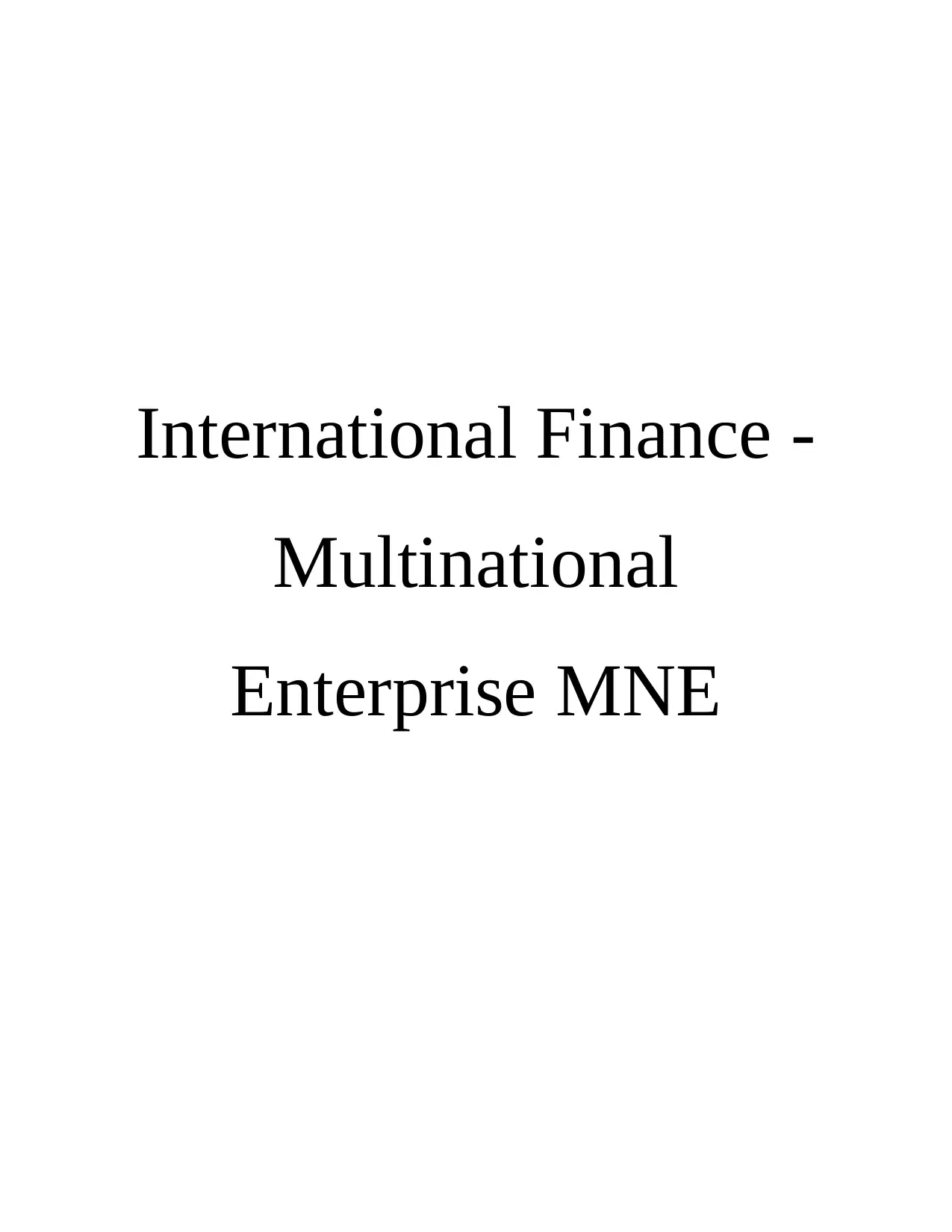
International Finance -
Multinational
Enterprise MNE
Multinational
Enterprise MNE
Secure Best Marks with AI Grader
Need help grading? Try our AI Grader for instant feedback on your assignments.

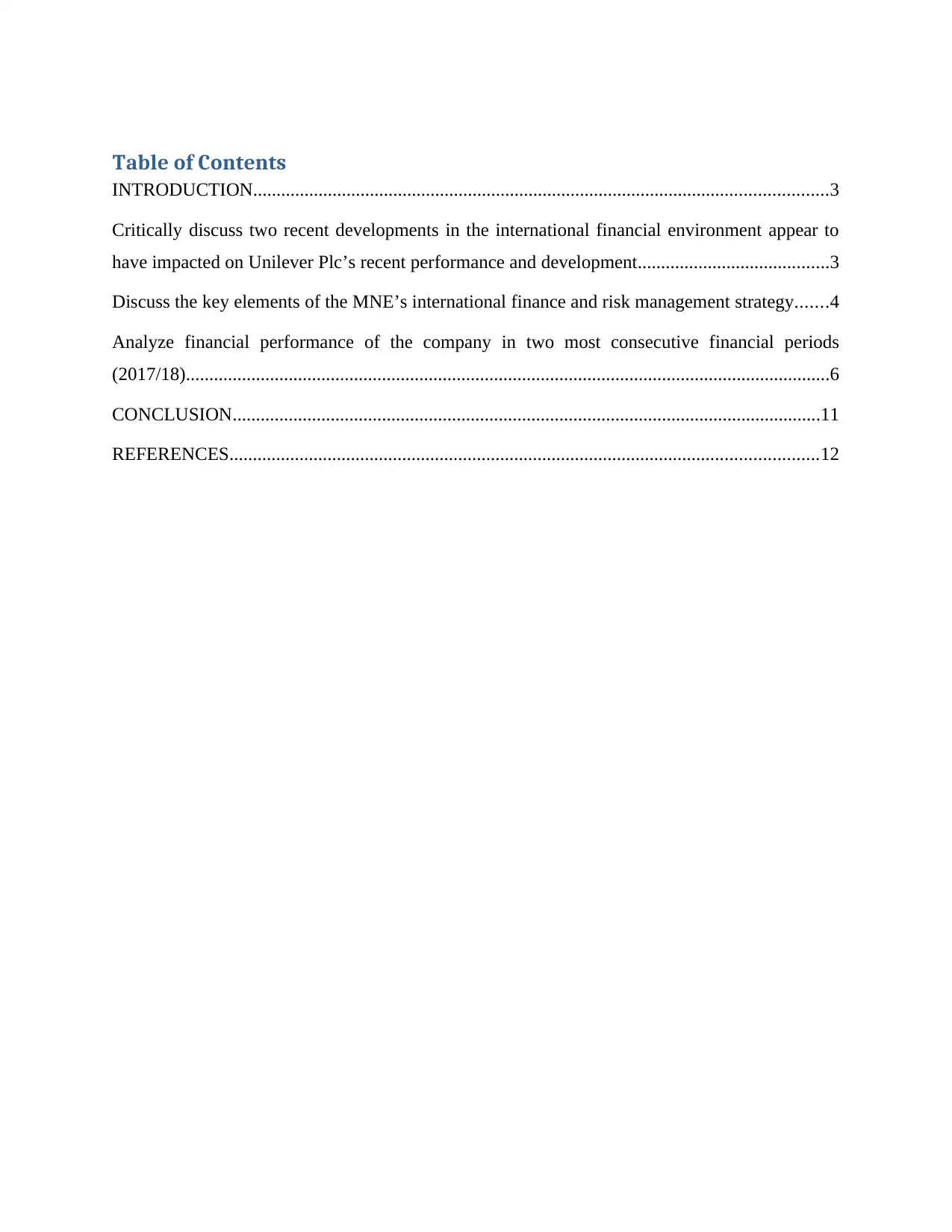
Table of Contents
INTRODUCTION...........................................................................................................................3
Critically discuss two recent developments in the international financial environment appear to
have impacted on Unilever Plc’s recent performance and development.........................................3
Discuss the key elements of the MNE’s international finance and risk management strategy.......4
Analyze financial performance of the company in two most consecutive financial periods
(2017/18)..........................................................................................................................................6
CONCLUSION..............................................................................................................................11
REFERENCES..............................................................................................................................12
INTRODUCTION...........................................................................................................................3
Critically discuss two recent developments in the international financial environment appear to
have impacted on Unilever Plc’s recent performance and development.........................................3
Discuss the key elements of the MNE’s international finance and risk management strategy.......4
Analyze financial performance of the company in two most consecutive financial periods
(2017/18)..........................................................................................................................................6
CONCLUSION..............................................................................................................................11
REFERENCES..............................................................................................................................12
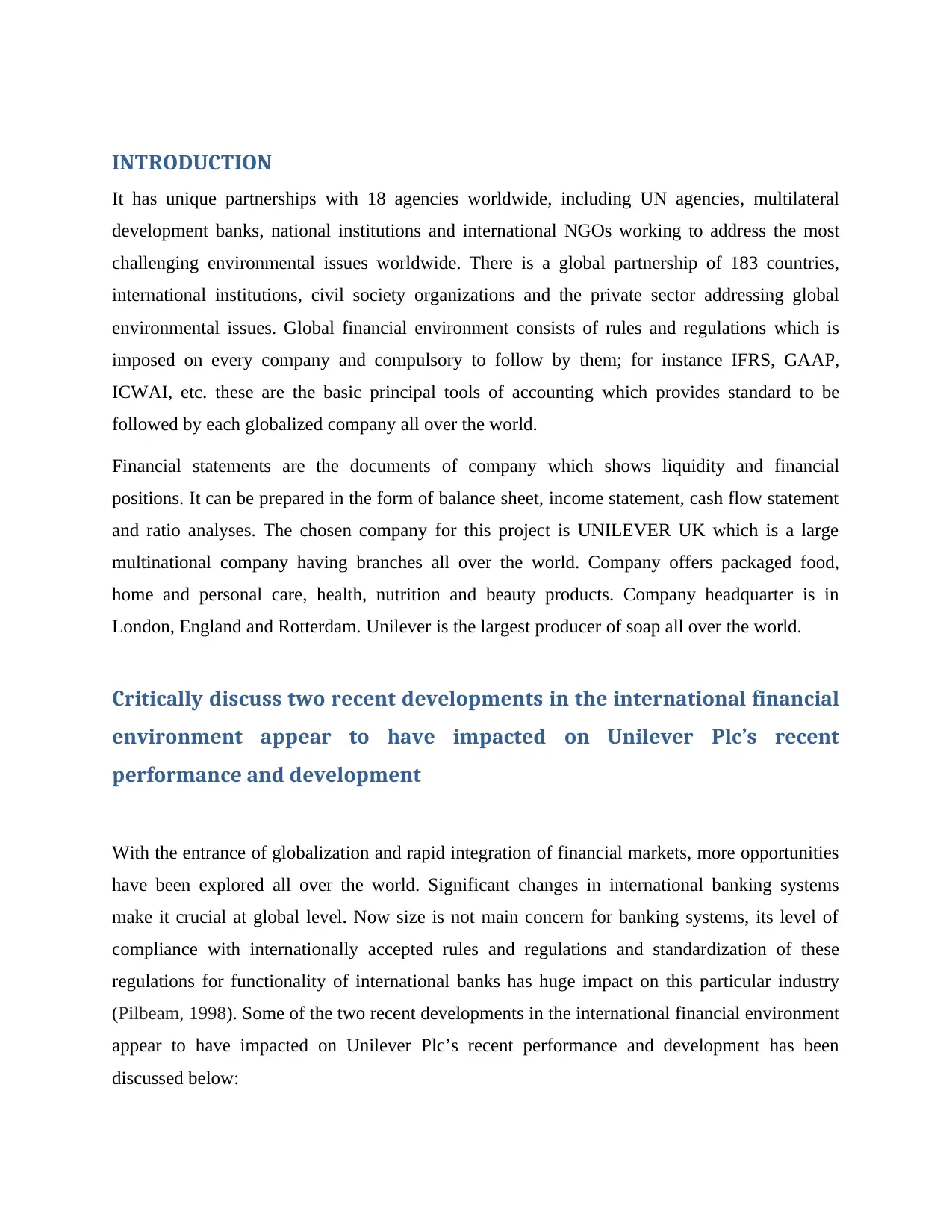
INTRODUCTION
It has unique partnerships with 18 agencies worldwide, including UN agencies, multilateral
development banks, national institutions and international NGOs working to address the most
challenging environmental issues worldwide. There is a global partnership of 183 countries,
international institutions, civil society organizations and the private sector addressing global
environmental issues. Global financial environment consists of rules and regulations which is
imposed on every company and compulsory to follow by them; for instance IFRS, GAAP,
ICWAI, etc. these are the basic principal tools of accounting which provides standard to be
followed by each globalized company all over the world.
Financial statements are the documents of company which shows liquidity and financial
positions. It can be prepared in the form of balance sheet, income statement, cash flow statement
and ratio analyses. The chosen company for this project is UNILEVER UK which is a large
multinational company having branches all over the world. Company offers packaged food,
home and personal care, health, nutrition and beauty products. Company headquarter is in
London, England and Rotterdam. Unilever is the largest producer of soap all over the world.
Critically discuss two recent developments in the international financial
environment appear to have impacted on Unilever Plc’s recent
performance and development
With the entrance of globalization and rapid integration of financial markets, more opportunities
have been explored all over the world. Significant changes in international banking systems
make it crucial at global level. Now size is not main concern for banking systems, its level of
compliance with internationally accepted rules and regulations and standardization of these
regulations for functionality of international banks has huge impact on this particular industry
(Pilbeam, 1998). Some of the two recent developments in the international financial environment
appear to have impacted on Unilever Plc’s recent performance and development has been
discussed below:
It has unique partnerships with 18 agencies worldwide, including UN agencies, multilateral
development banks, national institutions and international NGOs working to address the most
challenging environmental issues worldwide. There is a global partnership of 183 countries,
international institutions, civil society organizations and the private sector addressing global
environmental issues. Global financial environment consists of rules and regulations which is
imposed on every company and compulsory to follow by them; for instance IFRS, GAAP,
ICWAI, etc. these are the basic principal tools of accounting which provides standard to be
followed by each globalized company all over the world.
Financial statements are the documents of company which shows liquidity and financial
positions. It can be prepared in the form of balance sheet, income statement, cash flow statement
and ratio analyses. The chosen company for this project is UNILEVER UK which is a large
multinational company having branches all over the world. Company offers packaged food,
home and personal care, health, nutrition and beauty products. Company headquarter is in
London, England and Rotterdam. Unilever is the largest producer of soap all over the world.
Critically discuss two recent developments in the international financial
environment appear to have impacted on Unilever Plc’s recent
performance and development
With the entrance of globalization and rapid integration of financial markets, more opportunities
have been explored all over the world. Significant changes in international banking systems
make it crucial at global level. Now size is not main concern for banking systems, its level of
compliance with internationally accepted rules and regulations and standardization of these
regulations for functionality of international banks has huge impact on this particular industry
(Pilbeam, 1998). Some of the two recent developments in the international financial environment
appear to have impacted on Unilever Plc’s recent performance and development has been
discussed below:
Secure Best Marks with AI Grader
Need help grading? Try our AI Grader for instant feedback on your assignments.
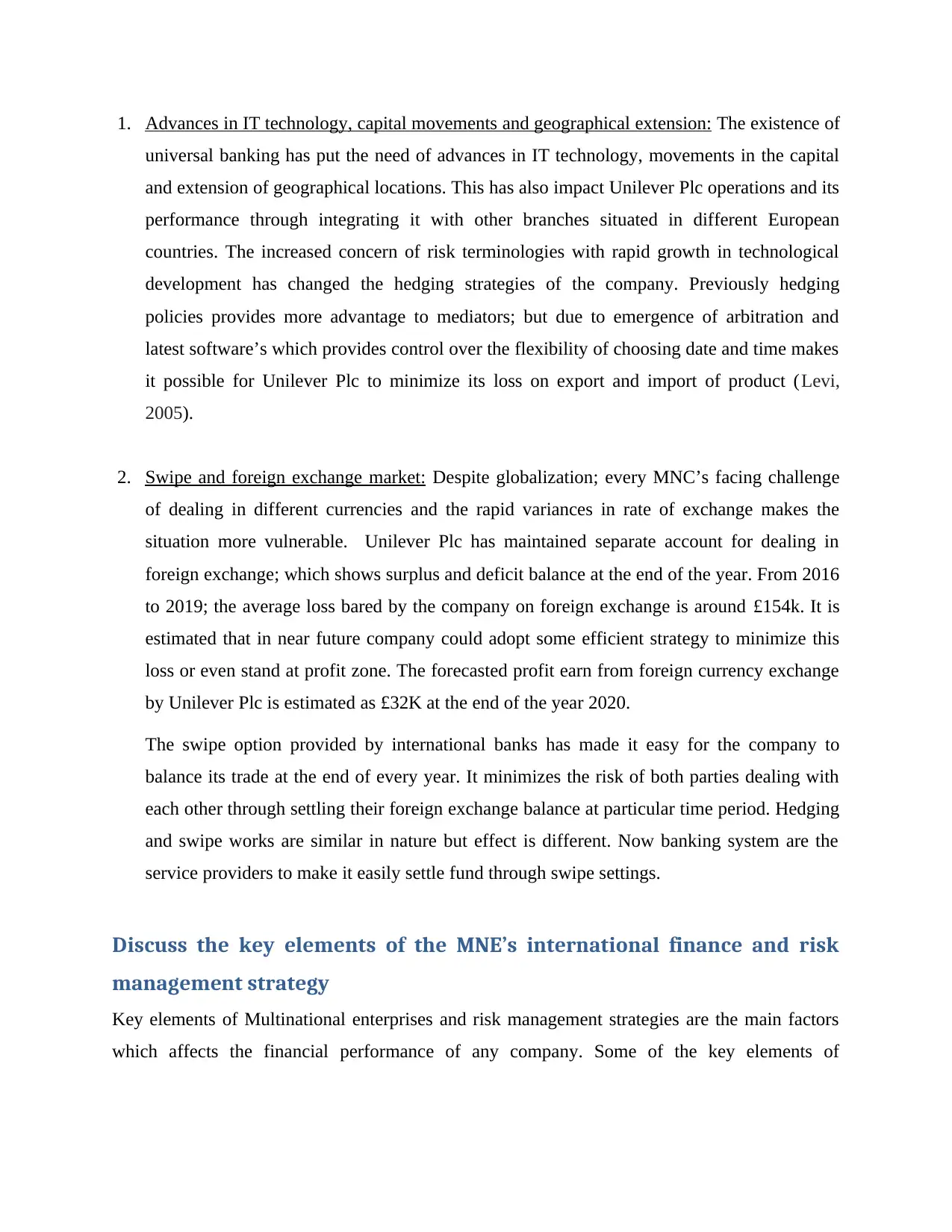
1. Advances in IT technology, capital movements and geographical extension: The existence of
universal banking has put the need of advances in IT technology, movements in the capital
and extension of geographical locations. This has also impact Unilever Plc operations and its
performance through integrating it with other branches situated in different European
countries. The increased concern of risk terminologies with rapid growth in technological
development has changed the hedging strategies of the company. Previously hedging
policies provides more advantage to mediators; but due to emergence of arbitration and
latest software’s which provides control over the flexibility of choosing date and time makes
it possible for Unilever Plc to minimize its loss on export and import of product (Levi,
2005).
2. Swipe and foreign exchange market: Despite globalization; every MNC’s facing challenge
of dealing in different currencies and the rapid variances in rate of exchange makes the
situation more vulnerable. Unilever Plc has maintained separate account for dealing in
foreign exchange; which shows surplus and deficit balance at the end of the year. From 2016
to 2019; the average loss bared by the company on foreign exchange is around £154k. It is
estimated that in near future company could adopt some efficient strategy to minimize this
loss or even stand at profit zone. The forecasted profit earn from foreign currency exchange
by Unilever Plc is estimated as £32K at the end of the year 2020.
The swipe option provided by international banks has made it easy for the company to
balance its trade at the end of every year. It minimizes the risk of both parties dealing with
each other through settling their foreign exchange balance at particular time period. Hedging
and swipe works are similar in nature but effect is different. Now banking system are the
service providers to make it easily settle fund through swipe settings.
Discuss the key elements of the MNE’s international finance and risk
management strategy
Key elements of Multinational enterprises and risk management strategies are the main factors
which affects the financial performance of any company. Some of the key elements of
universal banking has put the need of advances in IT technology, movements in the capital
and extension of geographical locations. This has also impact Unilever Plc operations and its
performance through integrating it with other branches situated in different European
countries. The increased concern of risk terminologies with rapid growth in technological
development has changed the hedging strategies of the company. Previously hedging
policies provides more advantage to mediators; but due to emergence of arbitration and
latest software’s which provides control over the flexibility of choosing date and time makes
it possible for Unilever Plc to minimize its loss on export and import of product (Levi,
2005).
2. Swipe and foreign exchange market: Despite globalization; every MNC’s facing challenge
of dealing in different currencies and the rapid variances in rate of exchange makes the
situation more vulnerable. Unilever Plc has maintained separate account for dealing in
foreign exchange; which shows surplus and deficit balance at the end of the year. From 2016
to 2019; the average loss bared by the company on foreign exchange is around £154k. It is
estimated that in near future company could adopt some efficient strategy to minimize this
loss or even stand at profit zone. The forecasted profit earn from foreign currency exchange
by Unilever Plc is estimated as £32K at the end of the year 2020.
The swipe option provided by international banks has made it easy for the company to
balance its trade at the end of every year. It minimizes the risk of both parties dealing with
each other through settling their foreign exchange balance at particular time period. Hedging
and swipe works are similar in nature but effect is different. Now banking system are the
service providers to make it easily settle fund through swipe settings.
Discuss the key elements of the MNE’s international finance and risk
management strategy
Key elements of Multinational enterprises and risk management strategies are the main factors
which affects the financial performance of any company. Some of the key elements of
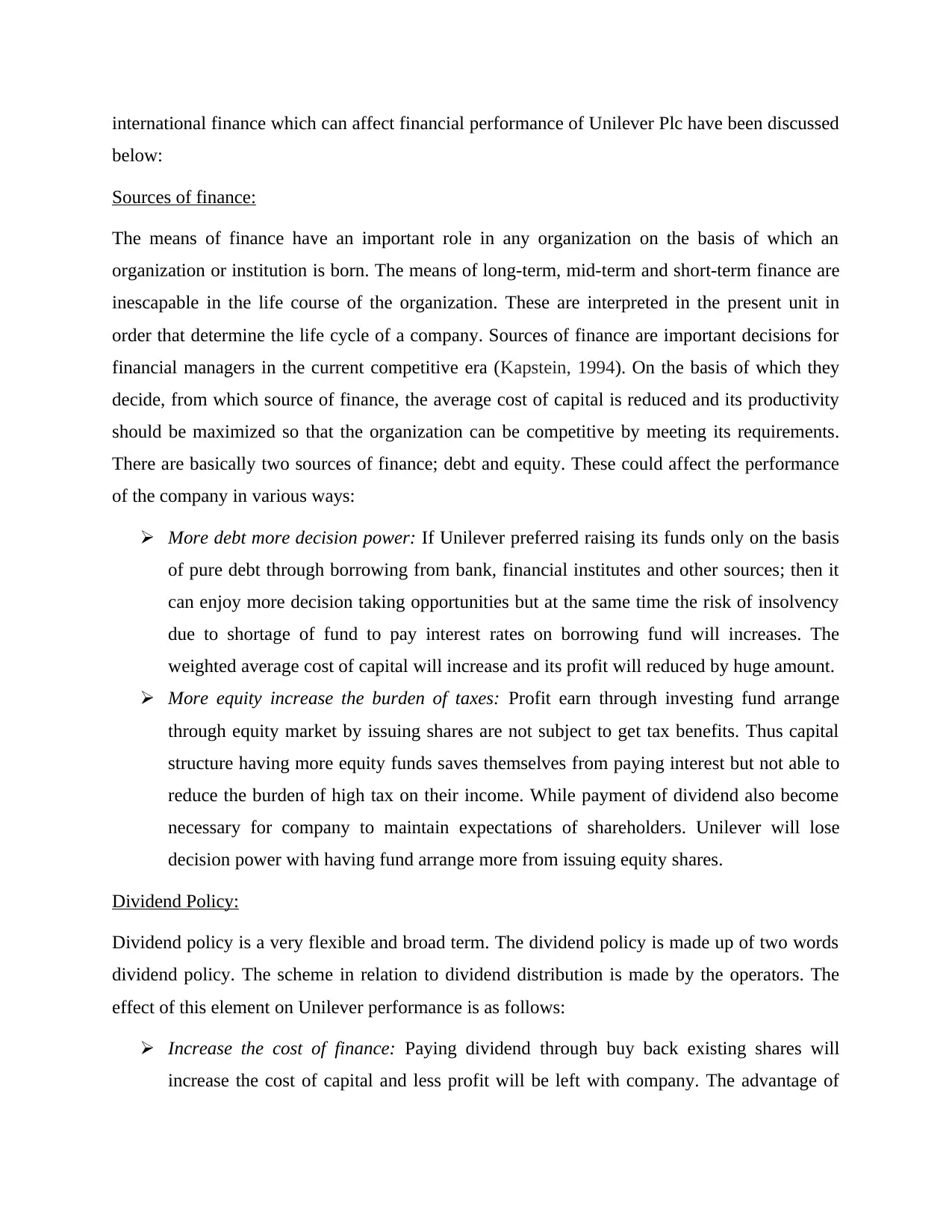
international finance which can affect financial performance of Unilever Plc have been discussed
below:
Sources of finance:
The means of finance have an important role in any organization on the basis of which an
organization or institution is born. The means of long-term, mid-term and short-term finance are
inescapable in the life course of the organization. These are interpreted in the present unit in
order that determine the life cycle of a company. Sources of finance are important decisions for
financial managers in the current competitive era (Kapstein, 1994). On the basis of which they
decide, from which source of finance, the average cost of capital is reduced and its productivity
should be maximized so that the organization can be competitive by meeting its requirements.
There are basically two sources of finance; debt and equity. These could affect the performance
of the company in various ways:
More debt more decision power: If Unilever preferred raising its funds only on the basis
of pure debt through borrowing from bank, financial institutes and other sources; then it
can enjoy more decision taking opportunities but at the same time the risk of insolvency
due to shortage of fund to pay interest rates on borrowing fund will increases. The
weighted average cost of capital will increase and its profit will reduced by huge amount.
More equity increase the burden of taxes: Profit earn through investing fund arrange
through equity market by issuing shares are not subject to get tax benefits. Thus capital
structure having more equity funds saves themselves from paying interest but not able to
reduce the burden of high tax on their income. While payment of dividend also become
necessary for company to maintain expectations of shareholders. Unilever will lose
decision power with having fund arrange more from issuing equity shares.
Dividend Policy:
Dividend policy is a very flexible and broad term. The dividend policy is made up of two words
dividend policy. The scheme in relation to dividend distribution is made by the operators. The
effect of this element on Unilever performance is as follows:
Increase the cost of finance: Paying dividend through buy back existing shares will
increase the cost of capital and less profit will be left with company. The advantage of
below:
Sources of finance:
The means of finance have an important role in any organization on the basis of which an
organization or institution is born. The means of long-term, mid-term and short-term finance are
inescapable in the life course of the organization. These are interpreted in the present unit in
order that determine the life cycle of a company. Sources of finance are important decisions for
financial managers in the current competitive era (Kapstein, 1994). On the basis of which they
decide, from which source of finance, the average cost of capital is reduced and its productivity
should be maximized so that the organization can be competitive by meeting its requirements.
There are basically two sources of finance; debt and equity. These could affect the performance
of the company in various ways:
More debt more decision power: If Unilever preferred raising its funds only on the basis
of pure debt through borrowing from bank, financial institutes and other sources; then it
can enjoy more decision taking opportunities but at the same time the risk of insolvency
due to shortage of fund to pay interest rates on borrowing fund will increases. The
weighted average cost of capital will increase and its profit will reduced by huge amount.
More equity increase the burden of taxes: Profit earn through investing fund arrange
through equity market by issuing shares are not subject to get tax benefits. Thus capital
structure having more equity funds saves themselves from paying interest but not able to
reduce the burden of high tax on their income. While payment of dividend also become
necessary for company to maintain expectations of shareholders. Unilever will lose
decision power with having fund arrange more from issuing equity shares.
Dividend Policy:
Dividend policy is a very flexible and broad term. The dividend policy is made up of two words
dividend policy. The scheme in relation to dividend distribution is made by the operators. The
effect of this element on Unilever performance is as follows:
Increase the cost of finance: Paying dividend through buy back existing shares will
increase the cost of capital and less profit will be left with company. The advantage of
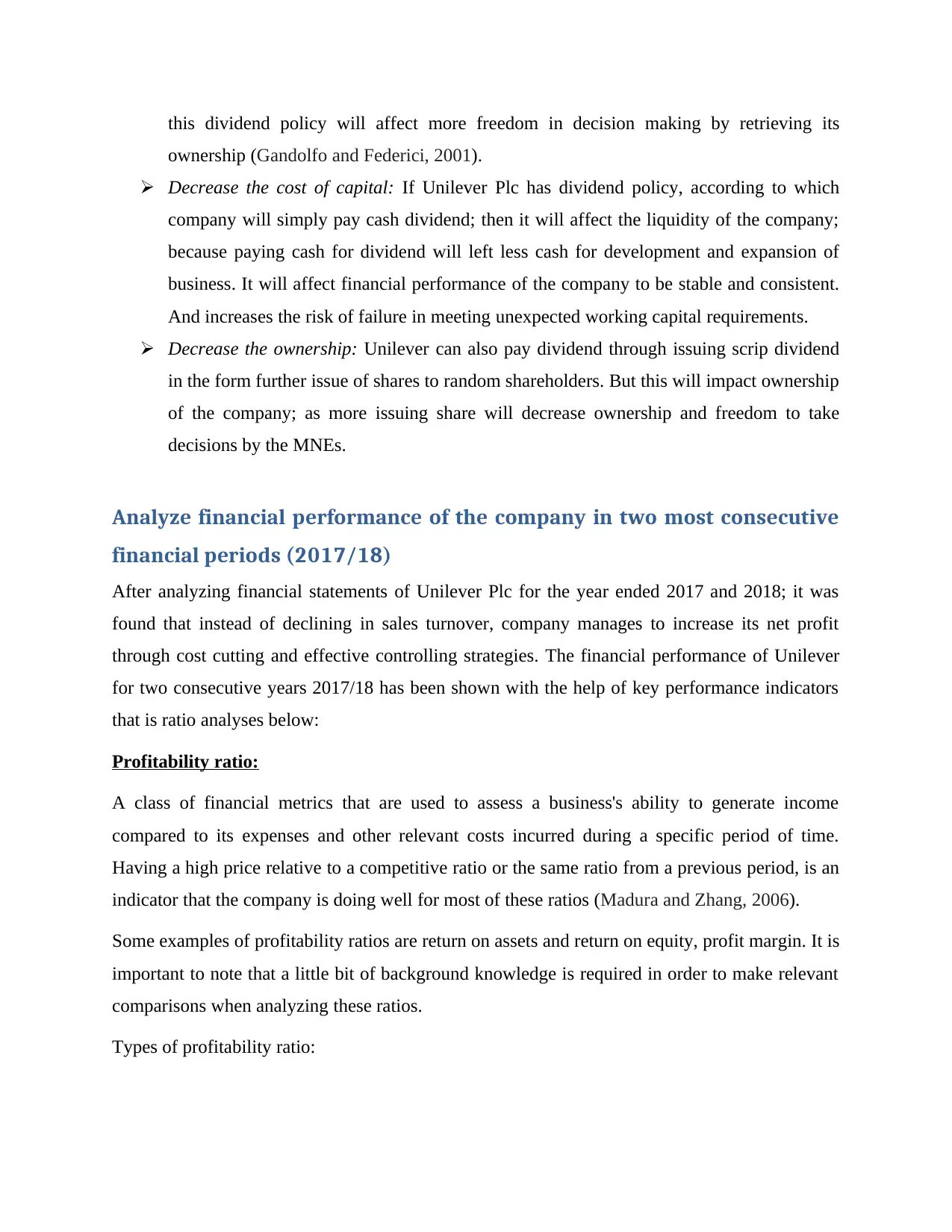
this dividend policy will affect more freedom in decision making by retrieving its
ownership (Gandolfo and Federici, 2001).
Decrease the cost of capital: If Unilever Plc has dividend policy, according to which
company will simply pay cash dividend; then it will affect the liquidity of the company;
because paying cash for dividend will left less cash for development and expansion of
business. It will affect financial performance of the company to be stable and consistent.
And increases the risk of failure in meeting unexpected working capital requirements.
Decrease the ownership: Unilever can also pay dividend through issuing scrip dividend
in the form further issue of shares to random shareholders. But this will impact ownership
of the company; as more issuing share will decrease ownership and freedom to take
decisions by the MNEs.
Analyze financial performance of the company in two most consecutive
financial periods (2017/18)
After analyzing financial statements of Unilever Plc for the year ended 2017 and 2018; it was
found that instead of declining in sales turnover, company manages to increase its net profit
through cost cutting and effective controlling strategies. The financial performance of Unilever
for two consecutive years 2017/18 has been shown with the help of key performance indicators
that is ratio analyses below:
Profitability ratio:
A class of financial metrics that are used to assess a business's ability to generate income
compared to its expenses and other relevant costs incurred during a specific period of time.
Having a high price relative to a competitive ratio or the same ratio from a previous period, is an
indicator that the company is doing well for most of these ratios (Madura and Zhang, 2006).
Some examples of profitability ratios are return on assets and return on equity, profit margin. It is
important to note that a little bit of background knowledge is required in order to make relevant
comparisons when analyzing these ratios.
Types of profitability ratio:
ownership (Gandolfo and Federici, 2001).
Decrease the cost of capital: If Unilever Plc has dividend policy, according to which
company will simply pay cash dividend; then it will affect the liquidity of the company;
because paying cash for dividend will left less cash for development and expansion of
business. It will affect financial performance of the company to be stable and consistent.
And increases the risk of failure in meeting unexpected working capital requirements.
Decrease the ownership: Unilever can also pay dividend through issuing scrip dividend
in the form further issue of shares to random shareholders. But this will impact ownership
of the company; as more issuing share will decrease ownership and freedom to take
decisions by the MNEs.
Analyze financial performance of the company in two most consecutive
financial periods (2017/18)
After analyzing financial statements of Unilever Plc for the year ended 2017 and 2018; it was
found that instead of declining in sales turnover, company manages to increase its net profit
through cost cutting and effective controlling strategies. The financial performance of Unilever
for two consecutive years 2017/18 has been shown with the help of key performance indicators
that is ratio analyses below:
Profitability ratio:
A class of financial metrics that are used to assess a business's ability to generate income
compared to its expenses and other relevant costs incurred during a specific period of time.
Having a high price relative to a competitive ratio or the same ratio from a previous period, is an
indicator that the company is doing well for most of these ratios (Madura and Zhang, 2006).
Some examples of profitability ratios are return on assets and return on equity, profit margin. It is
important to note that a little bit of background knowledge is required in order to make relevant
comparisons when analyzing these ratios.
Types of profitability ratio:
Paraphrase This Document
Need a fresh take? Get an instant paraphrase of this document with our AI Paraphraser
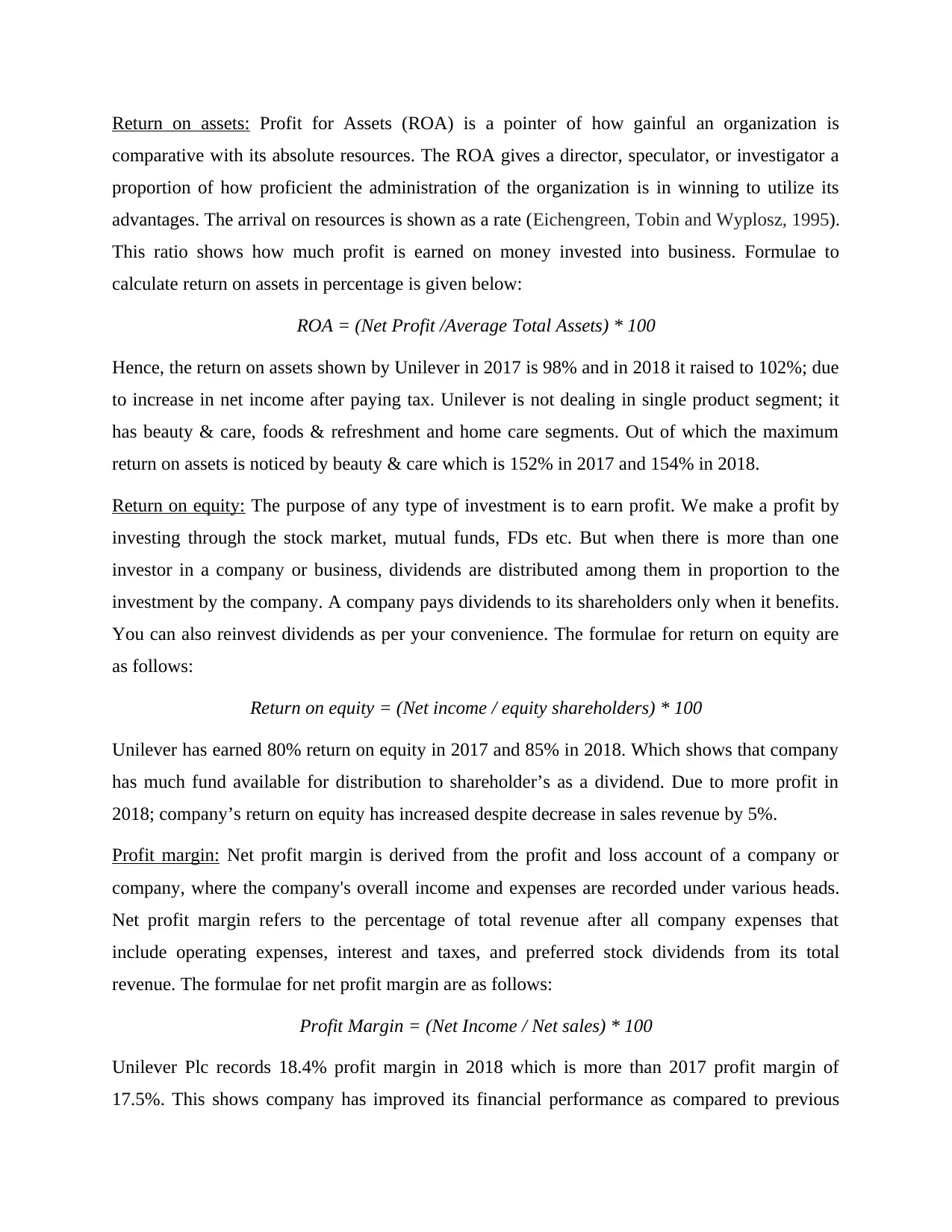
Return on assets: Profit for Assets (ROA) is a pointer of how gainful an organization is
comparative with its absolute resources. The ROA gives a director, speculator, or investigator a
proportion of how proficient the administration of the organization is in winning to utilize its
advantages. The arrival on resources is shown as a rate (Eichengreen, Tobin and Wyplosz, 1995).
This ratio shows how much profit is earned on money invested into business. Formulae to
calculate return on assets in percentage is given below:
ROA = (Net Profit /Average Total Assets) * 100
Hence, the return on assets shown by Unilever in 2017 is 98% and in 2018 it raised to 102%; due
to increase in net income after paying tax. Unilever is not dealing in single product segment; it
has beauty & care, foods & refreshment and home care segments. Out of which the maximum
return on assets is noticed by beauty & care which is 152% in 2017 and 154% in 2018.
Return on equity: The purpose of any type of investment is to earn profit. We make a profit by
investing through the stock market, mutual funds, FDs etc. But when there is more than one
investor in a company or business, dividends are distributed among them in proportion to the
investment by the company. A company pays dividends to its shareholders only when it benefits.
You can also reinvest dividends as per your convenience. The formulae for return on equity are
as follows:
Return on equity = (Net income / equity shareholders) * 100
Unilever has earned 80% return on equity in 2017 and 85% in 2018. Which shows that company
has much fund available for distribution to shareholder’s as a dividend. Due to more profit in
2018; company’s return on equity has increased despite decrease in sales revenue by 5%.
Profit margin: Net profit margin is derived from the profit and loss account of a company or
company, where the company's overall income and expenses are recorded under various heads.
Net profit margin refers to the percentage of total revenue after all company expenses that
include operating expenses, interest and taxes, and preferred stock dividends from its total
revenue. The formulae for net profit margin are as follows:
Profit Margin = (Net Income / Net sales) * 100
Unilever Plc records 18.4% profit margin in 2018 which is more than 2017 profit margin of
17.5%. This shows company has improved its financial performance as compared to previous
comparative with its absolute resources. The ROA gives a director, speculator, or investigator a
proportion of how proficient the administration of the organization is in winning to utilize its
advantages. The arrival on resources is shown as a rate (Eichengreen, Tobin and Wyplosz, 1995).
This ratio shows how much profit is earned on money invested into business. Formulae to
calculate return on assets in percentage is given below:
ROA = (Net Profit /Average Total Assets) * 100
Hence, the return on assets shown by Unilever in 2017 is 98% and in 2018 it raised to 102%; due
to increase in net income after paying tax. Unilever is not dealing in single product segment; it
has beauty & care, foods & refreshment and home care segments. Out of which the maximum
return on assets is noticed by beauty & care which is 152% in 2017 and 154% in 2018.
Return on equity: The purpose of any type of investment is to earn profit. We make a profit by
investing through the stock market, mutual funds, FDs etc. But when there is more than one
investor in a company or business, dividends are distributed among them in proportion to the
investment by the company. A company pays dividends to its shareholders only when it benefits.
You can also reinvest dividends as per your convenience. The formulae for return on equity are
as follows:
Return on equity = (Net income / equity shareholders) * 100
Unilever has earned 80% return on equity in 2017 and 85% in 2018. Which shows that company
has much fund available for distribution to shareholder’s as a dividend. Due to more profit in
2018; company’s return on equity has increased despite decrease in sales revenue by 5%.
Profit margin: Net profit margin is derived from the profit and loss account of a company or
company, where the company's overall income and expenses are recorded under various heads.
Net profit margin refers to the percentage of total revenue after all company expenses that
include operating expenses, interest and taxes, and preferred stock dividends from its total
revenue. The formulae for net profit margin are as follows:
Profit Margin = (Net Income / Net sales) * 100
Unilever Plc records 18.4% profit margin in 2018 which is more than 2017 profit margin of
17.5%. This shows company has improved its financial performance as compared to previous
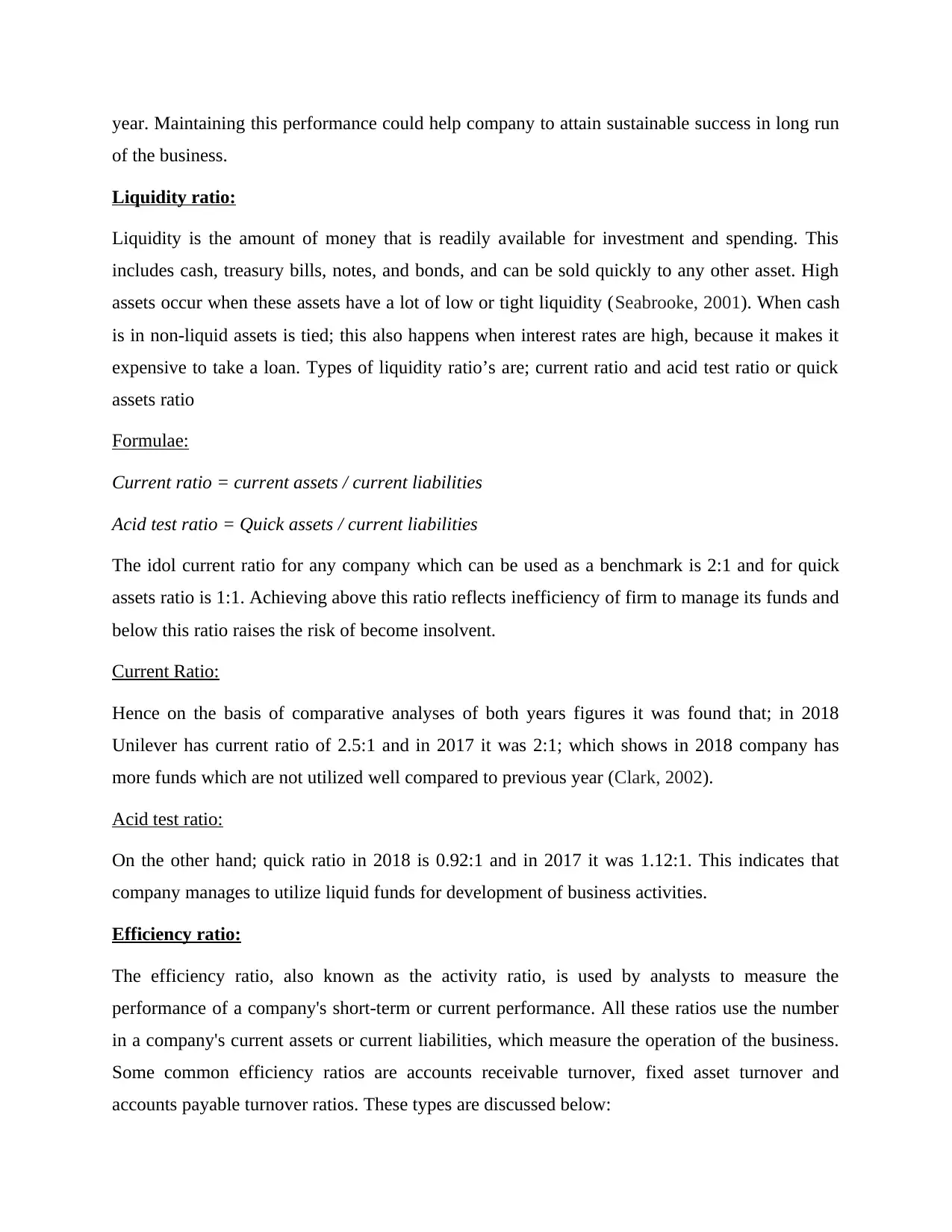
year. Maintaining this performance could help company to attain sustainable success in long run
of the business.
Liquidity ratio:
Liquidity is the amount of money that is readily available for investment and spending. This
includes cash, treasury bills, notes, and bonds, and can be sold quickly to any other asset. High
assets occur when these assets have a lot of low or tight liquidity (Seabrooke, 2001). When cash
is in non-liquid assets is tied; this also happens when interest rates are high, because it makes it
expensive to take a loan. Types of liquidity ratio’s are; current ratio and acid test ratio or quick
assets ratio
Formulae:
Current ratio = current assets / current liabilities
Acid test ratio = Quick assets / current liabilities
The idol current ratio for any company which can be used as a benchmark is 2:1 and for quick
assets ratio is 1:1. Achieving above this ratio reflects inefficiency of firm to manage its funds and
below this ratio raises the risk of become insolvent.
Current Ratio:
Hence on the basis of comparative analyses of both years figures it was found that; in 2018
Unilever has current ratio of 2.5:1 and in 2017 it was 2:1; which shows in 2018 company has
more funds which are not utilized well compared to previous year (Clark, 2002).
Acid test ratio:
On the other hand; quick ratio in 2018 is 0.92:1 and in 2017 it was 1.12:1. This indicates that
company manages to utilize liquid funds for development of business activities.
Efficiency ratio:
The efficiency ratio, also known as the activity ratio, is used by analysts to measure the
performance of a company's short-term or current performance. All these ratios use the number
in a company's current assets or current liabilities, which measure the operation of the business.
Some common efficiency ratios are accounts receivable turnover, fixed asset turnover and
accounts payable turnover ratios. These types are discussed below:
of the business.
Liquidity ratio:
Liquidity is the amount of money that is readily available for investment and spending. This
includes cash, treasury bills, notes, and bonds, and can be sold quickly to any other asset. High
assets occur when these assets have a lot of low or tight liquidity (Seabrooke, 2001). When cash
is in non-liquid assets is tied; this also happens when interest rates are high, because it makes it
expensive to take a loan. Types of liquidity ratio’s are; current ratio and acid test ratio or quick
assets ratio
Formulae:
Current ratio = current assets / current liabilities
Acid test ratio = Quick assets / current liabilities
The idol current ratio for any company which can be used as a benchmark is 2:1 and for quick
assets ratio is 1:1. Achieving above this ratio reflects inefficiency of firm to manage its funds and
below this ratio raises the risk of become insolvent.
Current Ratio:
Hence on the basis of comparative analyses of both years figures it was found that; in 2018
Unilever has current ratio of 2.5:1 and in 2017 it was 2:1; which shows in 2018 company has
more funds which are not utilized well compared to previous year (Clark, 2002).
Acid test ratio:
On the other hand; quick ratio in 2018 is 0.92:1 and in 2017 it was 1.12:1. This indicates that
company manages to utilize liquid funds for development of business activities.
Efficiency ratio:
The efficiency ratio, also known as the activity ratio, is used by analysts to measure the
performance of a company's short-term or current performance. All these ratios use the number
in a company's current assets or current liabilities, which measure the operation of the business.
Some common efficiency ratios are accounts receivable turnover, fixed asset turnover and
accounts payable turnover ratios. These types are discussed below:
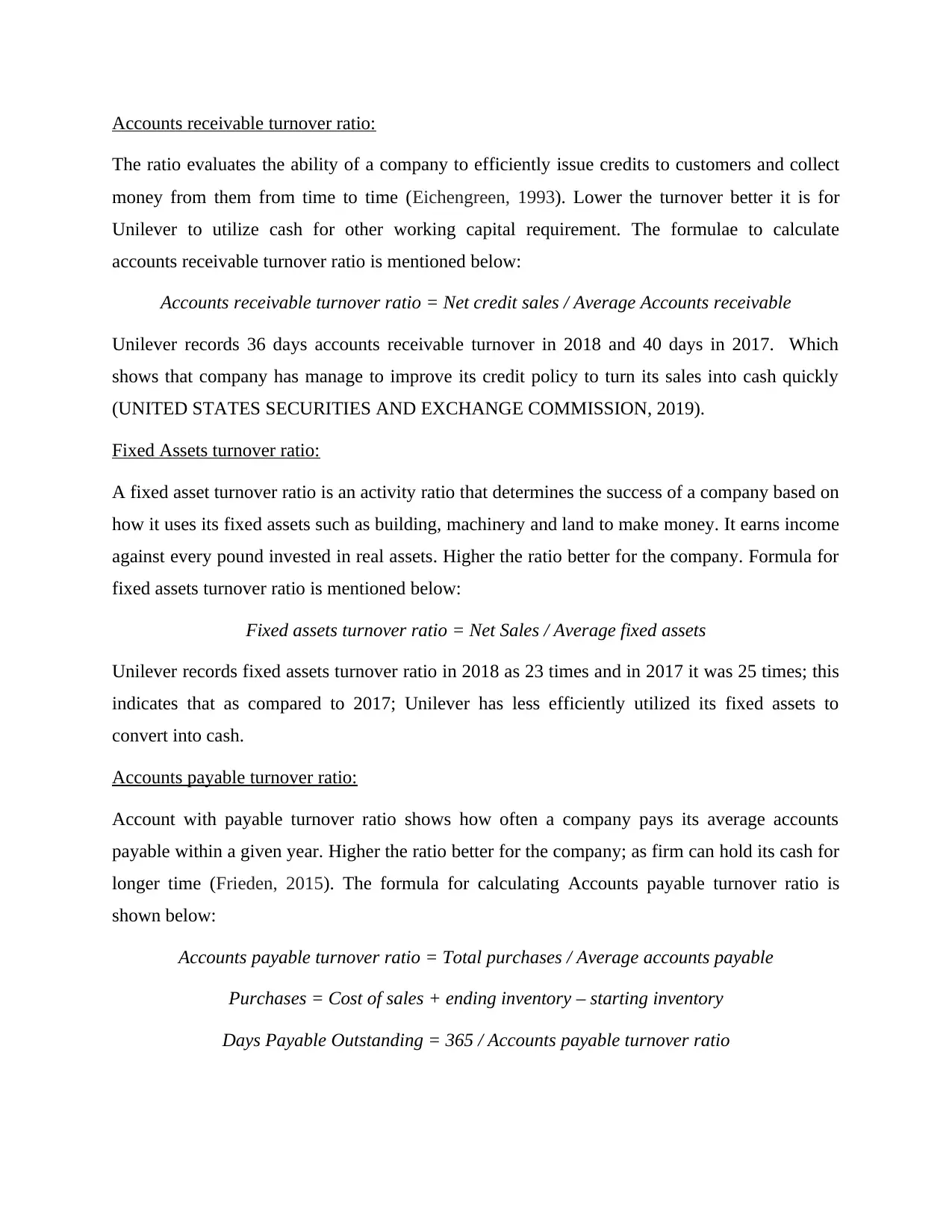
Accounts receivable turnover ratio:
The ratio evaluates the ability of a company to efficiently issue credits to customers and collect
money from them from time to time (Eichengreen, 1993). Lower the turnover better it is for
Unilever to utilize cash for other working capital requirement. The formulae to calculate
accounts receivable turnover ratio is mentioned below:
Accounts receivable turnover ratio = Net credit sales / Average Accounts receivable
Unilever records 36 days accounts receivable turnover in 2018 and 40 days in 2017. Which
shows that company has manage to improve its credit policy to turn its sales into cash quickly
(UNITED STATES SECURITIES AND EXCHANGE COMMISSION, 2019).
Fixed Assets turnover ratio:
A fixed asset turnover ratio is an activity ratio that determines the success of a company based on
how it uses its fixed assets such as building, machinery and land to make money. It earns income
against every pound invested in real assets. Higher the ratio better for the company. Formula for
fixed assets turnover ratio is mentioned below:
Fixed assets turnover ratio = Net Sales / Average fixed assets
Unilever records fixed assets turnover ratio in 2018 as 23 times and in 2017 it was 25 times; this
indicates that as compared to 2017; Unilever has less efficiently utilized its fixed assets to
convert into cash.
Accounts payable turnover ratio:
Account with payable turnover ratio shows how often a company pays its average accounts
payable within a given year. Higher the ratio better for the company; as firm can hold its cash for
longer time (Frieden, 2015). The formula for calculating Accounts payable turnover ratio is
shown below:
Accounts payable turnover ratio = Total purchases / Average accounts payable
Purchases = Cost of sales + ending inventory – starting inventory
Days Payable Outstanding = 365 / Accounts payable turnover ratio
The ratio evaluates the ability of a company to efficiently issue credits to customers and collect
money from them from time to time (Eichengreen, 1993). Lower the turnover better it is for
Unilever to utilize cash for other working capital requirement. The formulae to calculate
accounts receivable turnover ratio is mentioned below:
Accounts receivable turnover ratio = Net credit sales / Average Accounts receivable
Unilever records 36 days accounts receivable turnover in 2018 and 40 days in 2017. Which
shows that company has manage to improve its credit policy to turn its sales into cash quickly
(UNITED STATES SECURITIES AND EXCHANGE COMMISSION, 2019).
Fixed Assets turnover ratio:
A fixed asset turnover ratio is an activity ratio that determines the success of a company based on
how it uses its fixed assets such as building, machinery and land to make money. It earns income
against every pound invested in real assets. Higher the ratio better for the company. Formula for
fixed assets turnover ratio is mentioned below:
Fixed assets turnover ratio = Net Sales / Average fixed assets
Unilever records fixed assets turnover ratio in 2018 as 23 times and in 2017 it was 25 times; this
indicates that as compared to 2017; Unilever has less efficiently utilized its fixed assets to
convert into cash.
Accounts payable turnover ratio:
Account with payable turnover ratio shows how often a company pays its average accounts
payable within a given year. Higher the ratio better for the company; as firm can hold its cash for
longer time (Frieden, 2015). The formula for calculating Accounts payable turnover ratio is
shown below:
Accounts payable turnover ratio = Total purchases / Average accounts payable
Purchases = Cost of sales + ending inventory – starting inventory
Days Payable Outstanding = 365 / Accounts payable turnover ratio
Secure Best Marks with AI Grader
Need help grading? Try our AI Grader for instant feedback on your assignments.
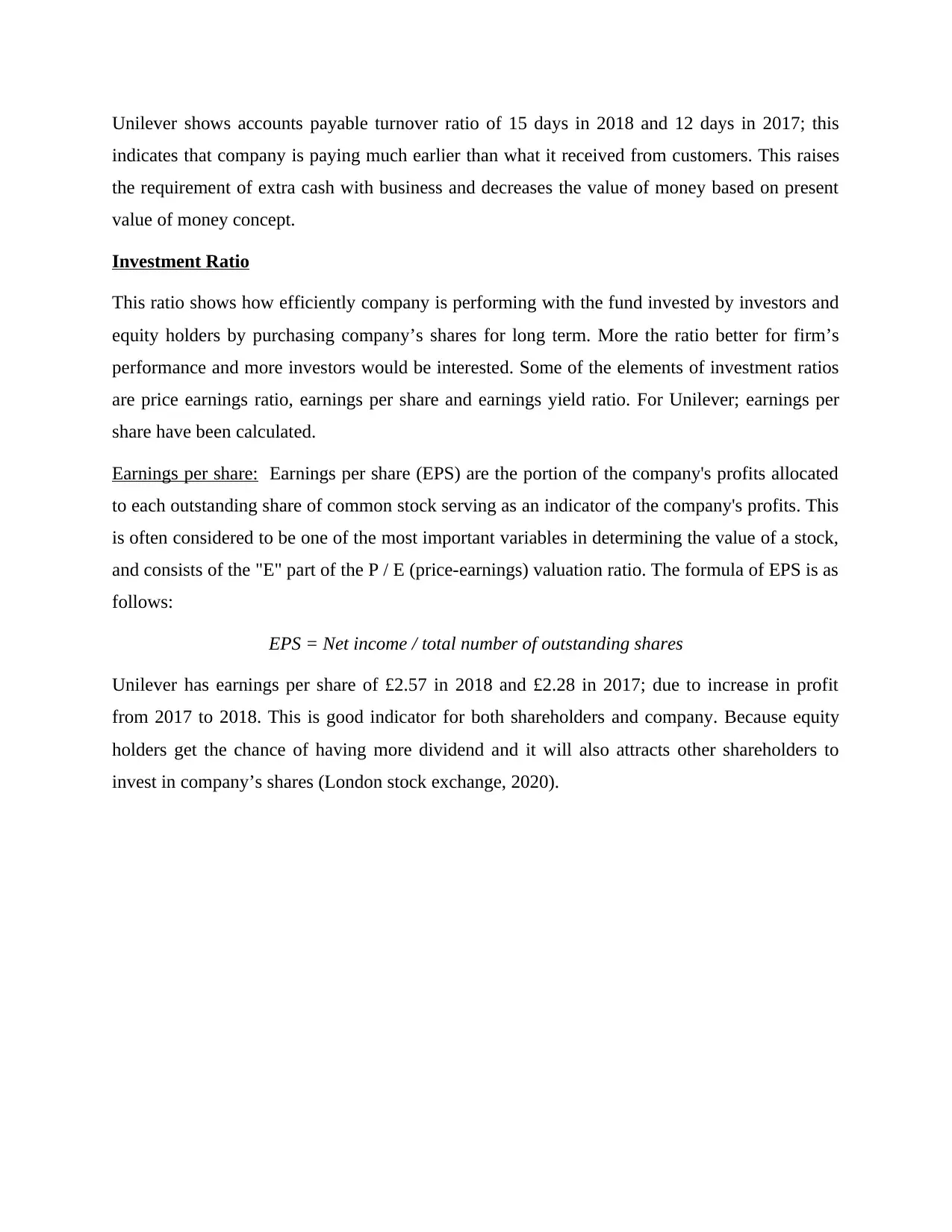
Unilever shows accounts payable turnover ratio of 15 days in 2018 and 12 days in 2017; this
indicates that company is paying much earlier than what it received from customers. This raises
the requirement of extra cash with business and decreases the value of money based on present
value of money concept.
Investment Ratio
This ratio shows how efficiently company is performing with the fund invested by investors and
equity holders by purchasing company’s shares for long term. More the ratio better for firm’s
performance and more investors would be interested. Some of the elements of investment ratios
are price earnings ratio, earnings per share and earnings yield ratio. For Unilever; earnings per
share have been calculated.
Earnings per share: Earnings per share (EPS) are the portion of the company's profits allocated
to each outstanding share of common stock serving as an indicator of the company's profits. This
is often considered to be one of the most important variables in determining the value of a stock,
and consists of the "E" part of the P / E (price-earnings) valuation ratio. The formula of EPS is as
follows:
EPS = Net income / total number of outstanding shares
Unilever has earnings per share of £2.57 in 2018 and £2.28 in 2017; due to increase in profit
from 2017 to 2018. This is good indicator for both shareholders and company. Because equity
holders get the chance of having more dividend and it will also attracts other shareholders to
invest in company’s shares (London stock exchange, 2020).
indicates that company is paying much earlier than what it received from customers. This raises
the requirement of extra cash with business and decreases the value of money based on present
value of money concept.
Investment Ratio
This ratio shows how efficiently company is performing with the fund invested by investors and
equity holders by purchasing company’s shares for long term. More the ratio better for firm’s
performance and more investors would be interested. Some of the elements of investment ratios
are price earnings ratio, earnings per share and earnings yield ratio. For Unilever; earnings per
share have been calculated.
Earnings per share: Earnings per share (EPS) are the portion of the company's profits allocated
to each outstanding share of common stock serving as an indicator of the company's profits. This
is often considered to be one of the most important variables in determining the value of a stock,
and consists of the "E" part of the P / E (price-earnings) valuation ratio. The formula of EPS is as
follows:
EPS = Net income / total number of outstanding shares
Unilever has earnings per share of £2.57 in 2018 and £2.28 in 2017; due to increase in profit
from 2017 to 2018. This is good indicator for both shareholders and company. Because equity
holders get the chance of having more dividend and it will also attracts other shareholders to
invest in company’s shares (London stock exchange, 2020).
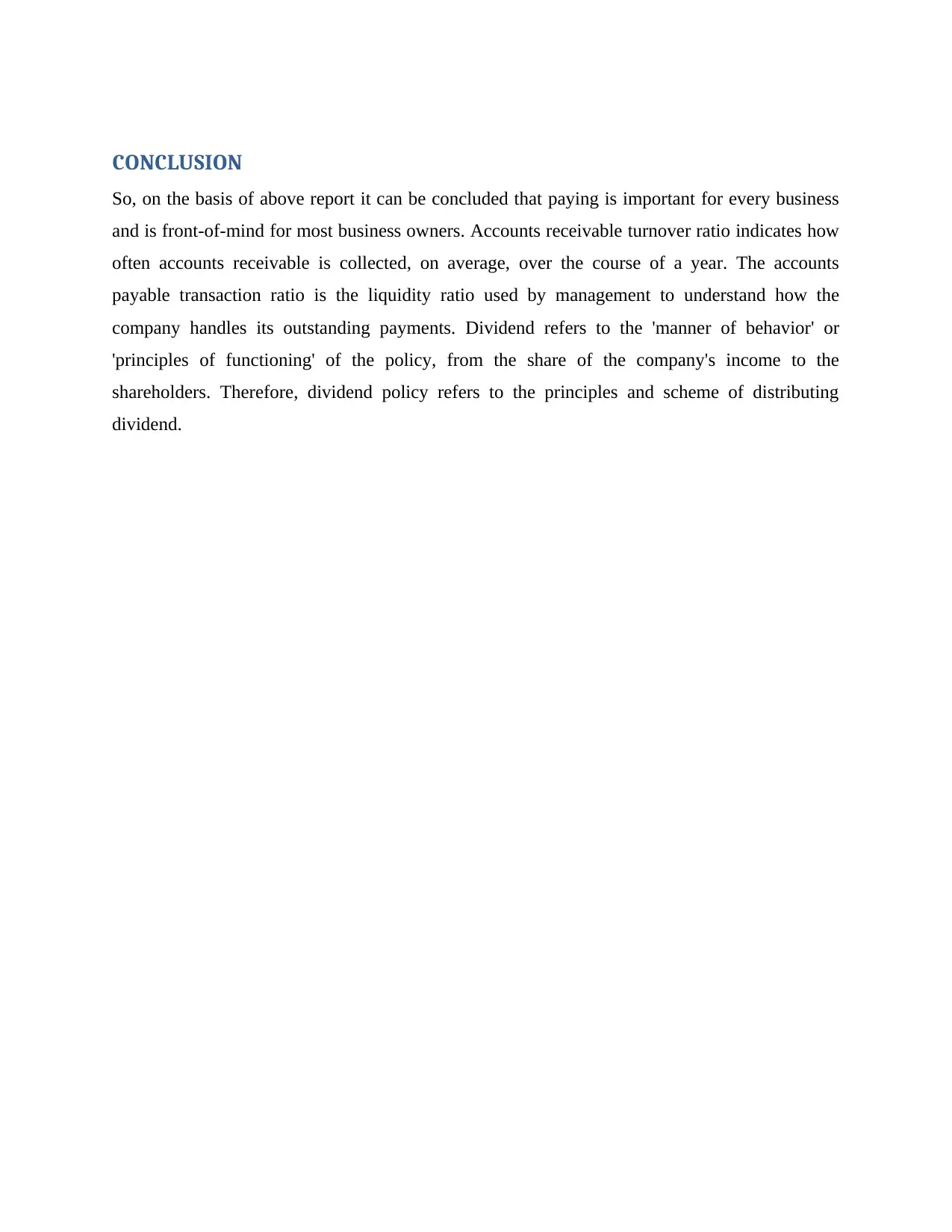
CONCLUSION
So, on the basis of above report it can be concluded that paying is important for every business
and is front-of-mind for most business owners. Accounts receivable turnover ratio indicates how
often accounts receivable is collected, on average, over the course of a year. The accounts
payable transaction ratio is the liquidity ratio used by management to understand how the
company handles its outstanding payments. Dividend refers to the 'manner of behavior' or
'principles of functioning' of the policy, from the share of the company's income to the
shareholders. Therefore, dividend policy refers to the principles and scheme of distributing
dividend.
So, on the basis of above report it can be concluded that paying is important for every business
and is front-of-mind for most business owners. Accounts receivable turnover ratio indicates how
often accounts receivable is collected, on average, over the course of a year. The accounts
payable transaction ratio is the liquidity ratio used by management to understand how the
company handles its outstanding payments. Dividend refers to the 'manner of behavior' or
'principles of functioning' of the policy, from the share of the company's income to the
shareholders. Therefore, dividend policy refers to the principles and scheme of distributing
dividend.
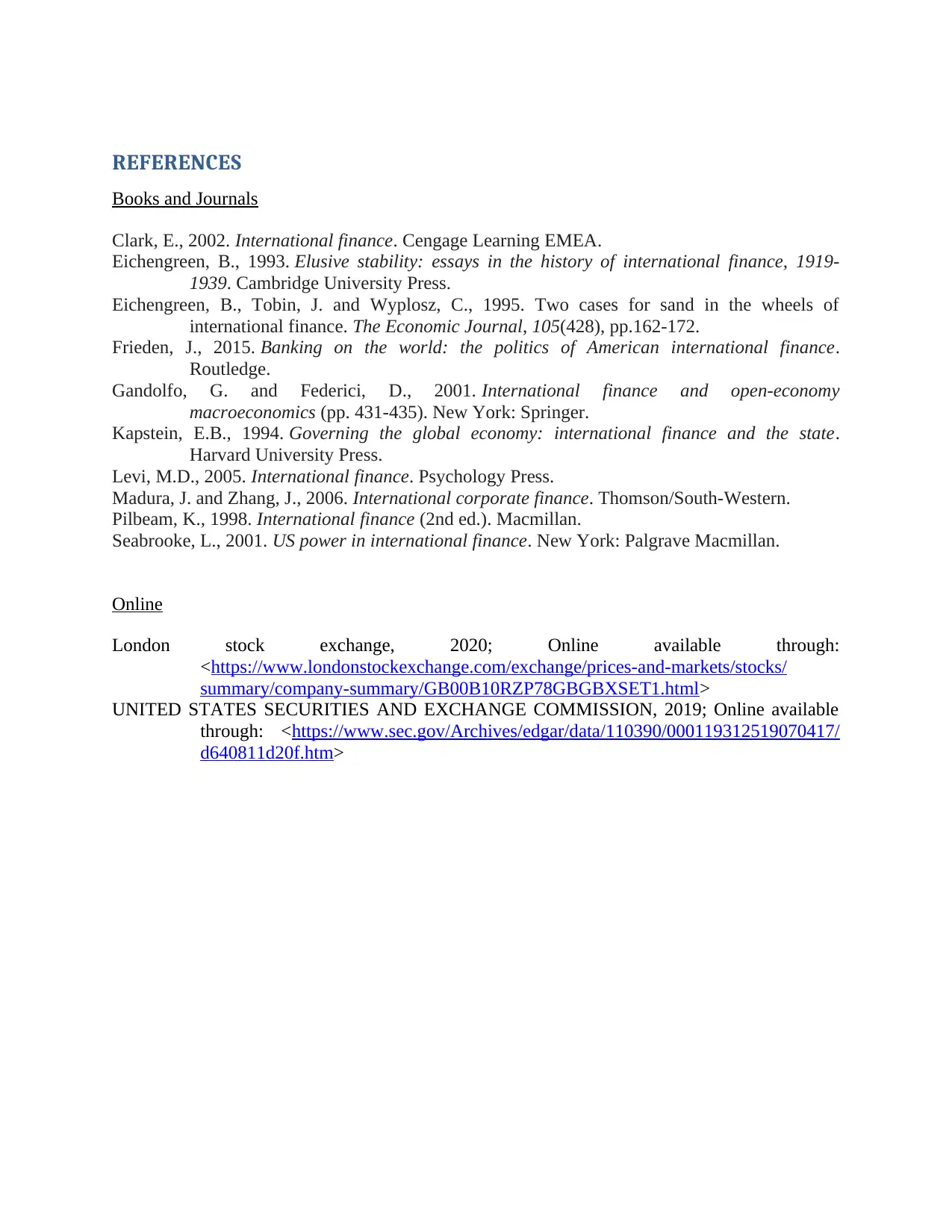
REFERENCES
Books and Journals
Clark, E., 2002. International finance. Cengage Learning EMEA.
Eichengreen, B., 1993. Elusive stability: essays in the history of international finance, 1919-
1939. Cambridge University Press.
Eichengreen, B., Tobin, J. and Wyplosz, C., 1995. Two cases for sand in the wheels of
international finance. The Economic Journal, 105(428), pp.162-172.
Frieden, J., 2015. Banking on the world: the politics of American international finance.
Routledge.
Gandolfo, G. and Federici, D., 2001. International finance and open-economy
macroeconomics (pp. 431-435). New York: Springer.
Kapstein, E.B., 1994. Governing the global economy: international finance and the state.
Harvard University Press.
Levi, M.D., 2005. International finance. Psychology Press.
Madura, J. and Zhang, J., 2006. International corporate finance. Thomson/South-Western.
Pilbeam, K., 1998. International finance (2nd ed.). Macmillan.
Seabrooke, L., 2001. US power in international finance. New York: Palgrave Macmillan.
Online
London stock exchange, 2020; Online available through:
<https://www.londonstockexchange.com/exchange/prices-and-markets/stocks/
summary/company-summary/GB00B10RZP78GBGBXSET1.html>
UNITED STATES SECURITIES AND EXCHANGE COMMISSION, 2019; Online available
through: <https://www.sec.gov/Archives/edgar/data/110390/000119312519070417/
d640811d20f.htm>
Books and Journals
Clark, E., 2002. International finance. Cengage Learning EMEA.
Eichengreen, B., 1993. Elusive stability: essays in the history of international finance, 1919-
1939. Cambridge University Press.
Eichengreen, B., Tobin, J. and Wyplosz, C., 1995. Two cases for sand in the wheels of
international finance. The Economic Journal, 105(428), pp.162-172.
Frieden, J., 2015. Banking on the world: the politics of American international finance.
Routledge.
Gandolfo, G. and Federici, D., 2001. International finance and open-economy
macroeconomics (pp. 431-435). New York: Springer.
Kapstein, E.B., 1994. Governing the global economy: international finance and the state.
Harvard University Press.
Levi, M.D., 2005. International finance. Psychology Press.
Madura, J. and Zhang, J., 2006. International corporate finance. Thomson/South-Western.
Pilbeam, K., 1998. International finance (2nd ed.). Macmillan.
Seabrooke, L., 2001. US power in international finance. New York: Palgrave Macmillan.
Online
London stock exchange, 2020; Online available through:
<https://www.londonstockexchange.com/exchange/prices-and-markets/stocks/
summary/company-summary/GB00B10RZP78GBGBXSET1.html>
UNITED STATES SECURITIES AND EXCHANGE COMMISSION, 2019; Online available
through: <https://www.sec.gov/Archives/edgar/data/110390/000119312519070417/
d640811d20f.htm>
1 out of 13
Related Documents
Your All-in-One AI-Powered Toolkit for Academic Success.
+13062052269
info@desklib.com
Available 24*7 on WhatsApp / Email
![[object Object]](/_next/static/media/star-bottom.7253800d.svg)
Unlock your academic potential
© 2024 | Zucol Services PVT LTD | All rights reserved.





